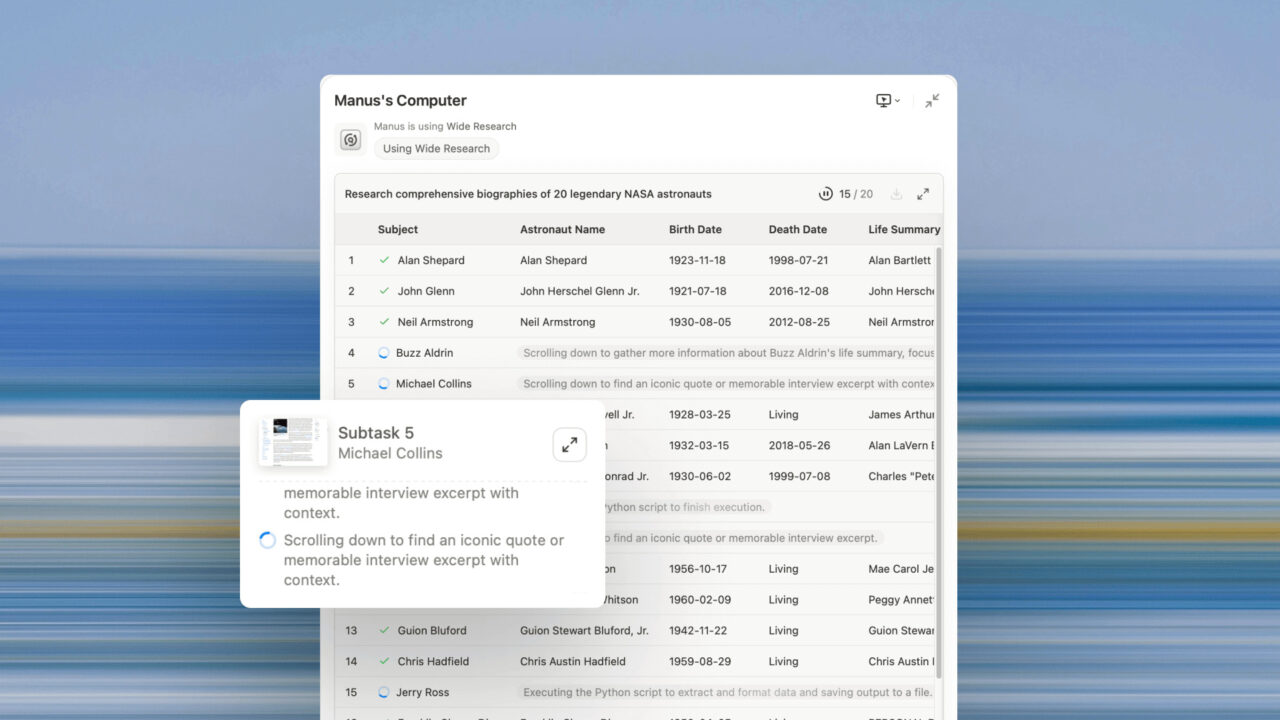August 4, 2025
5 min read
Markus Kasanmascheff
Manus AI launches Wide Research, deploying 100+ AI agents in parallel to revolutionize large-scale research tasks and challenge single-agent models.
Singapore-based AI startup Manus has launched Wide Research, a groundbreaking feature for its agentic platform that deploys over 100 AI agents in parallel to tackle large-scale tasks. Announced on July 31, 2025, this system contrasts sharply with the “Deep Research” tools from competitors like OpenAI and Google.
Manus describes this new capability as a personal supercomputing cluster, enabling users to orchestrate complex, high-volume research through natural language. Currently available to Manus Pro subscribers, the feature will gradually roll out to other subscription tiers, marking a new approach to scaling AI-driven productivity.
From Viral Sensation to Agentic Supercomputer
The launch builds on the significant buzz Manus generated in March 2025. Initially perceived as a Chinese AI venture, its parent company, Butterfly Effect, is now headquartered in Singapore—a strategic move in response to US-China tech tensions. The debut saw overwhelming demand, with partner Zhang Tao admitting, “we have completely underestimated the level of enthusiasm.”
Manus positions its core product not as an AI but as a “personal cloud computing platform.” In a recent blog post, the company explained its vision: “AI can democratize that power. Behind every Manus session runs a dedicated cloud-based virtual machine, allowing users to orchestrate complex cloud workloads — simply by talking to an agent.” Each agent is a Turing-complete virtual machine, forming the foundation for Wide Research.
How ‘Wide Research’ Reimagines AI Collaboration
At its core, Wide Research is a system for parallel processing and agent-to-agent collaboration. Instead of one agent digging deep, Manus spins up a swarm to work in concert, effectively giving users control of a personal supercomputing cluster just by chatting. The goal is to scale the available compute for a single task by a factor of 100, transforming how complex problems are addressed.
Practical applications demonstrate this breadth. In a demo, Wide Research was tasked with comparing 100 different sneakers. It instantly deployed 100 concurrent subagents, each analyzing one shoe, and returned a sortable matrix in spreadsheet and webpage formats within minutes. Another example showcased creative potential, with agents generating 50 distinct poster designs simultaneously, delivering polished assets in a single ZIP file.
The company emphasizes that “The key to Wide Research isn’t just having more agents — it’s how they collaborate.” Unlike traditional multi-agent systems with predefined roles like “manager” or “coder,” every subagent in Wide Research is a fully capable, general-purpose Manus instance running on its own virtual machine. This generality unlocks flexibility, ensuring tasks are not constrained by rigid formats or domains.
A Promising Architecture with Unproven Benefits
Wide Research is available now for users on the $199/month Pro plan, with access for Plus ($39/month) and Basic ($19/month) users to follow. However, Manus positions the feature as experimental, and despite ambitious claims, its practical benefits remain unproven.
Industry analysis points out the lack of empirical evidence supporting the “wide” approach. VentureBeat noted, “while the feature showcases architectural ambition, its practical benefits over simpler methods remain unproven based on the information provided.” Manus has not released performance benchmarks, direct comparisons to single-agent alternatives, or detailed technical explanations on subagent collaboration, result merging, or measurable advantages in speed, accuracy, or cost-efficiency.
These challenges are significant. Multi-agent systems are notoriously complex to develop and debug. Developers on other platforms report issues such as high token consumption, slow performance, and lack of execution transparency. Early independent reviews of Manus noted performance inconsistencies, including generating simulated data or getting stuck in loops. These highlight the steep technical climb Manus faces to ensure its agent swarms are reliable and efficient.
Moreover, Manus’s focus on autonomous operation has drawn regulatory scrutiny. Shortly after launch, Tennessee Governor Bill Lee banned Manus from state networks, citing risks of “censorship, propaganda, and bias.” Alabama followed with a similar prohibition over security vulnerabilities. This pushback reflects global unease with fully autonomous systems operating without human oversight, a core design principle of Manus.
Ultimately, Wide Research represents a bold experiment in scaling AI. As the agentic AI market matures, the line between visionary ambition and practical utility sharpens. Its success will depend on overcoming multi-agent coordination challenges and navigating regulatory skepticism to deliver tangible advantages over simpler, established methods.
Source: Manus AI Launches ‘Wide Research,’ Pitting 100-Agent Swarms Against ‘Deep Research‘ from Google and OpenAI
Source: Manus AI Launches ‘Wide Research,’ Pitting 100-Agent Swarms Against ‘Deep Research‘ from Google and OpenAI

